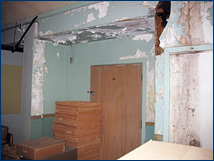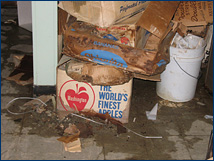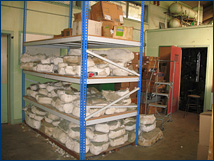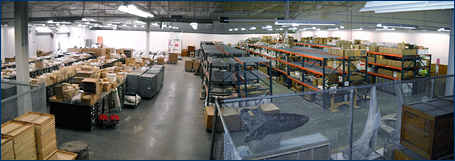


Images from the Clark-Kerr storage facility From left: The effects of age and a leaky roof on the walls. Boxes of specimens and matrix suffered water damage. Vertebrate fossils, still encased in their plaster jackets, sit in multi-level stacks.
UCMP — on the move!
by Mark Goodwin
Space, the final frontier … well, for UCMP not quite the final frontier, but new space for the continued growth and expansion of one of our most important resources — our collections!
Since the middle of March, assistant director Mark Goodwin and museum scientists Diane Erwin, Ken Finger, and Pat Holroyd, have been hard at work. More than 10,000 square feet of UCMP collections, spread across five separate rooms on the Clark-Kerr campus, were carefully repacked, labeled, and organized for safe transport to a dedicated 12,000-square-foot, climate-controlled space in the newly renovated Regatta Building. Located behind UC Berkeley's Richmond Field Station, the cavernous "Regatta" facility is about seven miles as the crow flies from UCMP's main home in the Valley Life Sciences Building and now houses multiple campus-wide museum collections.
The vision of Vice Provost Cathy Koshland, Academic Planning and Facilities, the indispensible and careful attention of Abram Hardin of Space Management and Capital Programs, the planning and organization by Gwojen Fung of Capital Projects, Tasha Dowdakin and Tamera Garlock of UC Moving Services, all converged with assorted campus representatives and architects to participate in a series of round table users' meetings over the past two years to get the job done. From here, a successful but challenging path was navigated by previous Director Roy Caldwell and current Director Charles Marshall, resulting in a large construction endeavor involving multiple partners, priceless collections and an aggressive timeline.
UCMP's holdings of fossils rank the institution among the top paleontology museums in the world. Deterioration to collections from overexposure to UV light, pests, moisture and vandalism, were threatening the health of those collections at Clark-Kerr, particularly over the past five years, and the resulting damage was significant to some specimens. This move ensures the collections will continue to benefit present and future generations of students, scientists, and the public. Some of these treasures now safely housed and accessible include:
Arco and Texaco oil companies' West Coast collections of more than two million vials of processed samples from outcrops and wells going back to the birth of foraminifera micropaleontology in the 1920s
And a few surprises! For example, a long lost sauropod vertebra from the Morrison Formation of Colorado was uncovered once again, as well as the oak typewriter desk belonging to Dr. Ruben "Stirt" Stirton, former Chair of the Department of Paleontology and Director of UCMP (1949-1955)! The latter will now serve current paleontologists working on their laptops in the new space, which also includes two conveniently located loading docks, parking, layout space, wireless, and a shared kitchen/break and conference room — all in a secure, alarmed facility.
A project of this kind is impossible without movers and UCMP is fortunate to have the strong back, care, and devoted attention of Nor-Cal foreman Rich Margie and his crew of movers, including his sons David and Derek. Rich oversaw the move of UCMP collections in 1995 from McCone Hall to the Valley Life Sciences Building and has a genuine fondness and appreciation for UCMP fossils that he instills in his crew. Thanks also go to Atthowe Fine Art Services who moved some of UCMP's largest and heaviest items. These included our 21-foot-long ichthyosaur skeleton collected in 1906 from the Middle Triassic of Nevada by J.C. Merriam, UC Berkeley's first professor of paleontology and Department of Paleontology Chair (1910-1920); the original works of art by UCMP artist William Huff, previously on display at the 1939-1940 Golden Gate International Exposition on Treasure Island; and one of the worlds' largest and best preserved Irish Elk skulls with a fearsome rack of antlers nearly 12 feet long from tip to tip.
The continued conservation, cataloguing and preservation of all UCMP collections take dedication, skill, and effort. Ongoing conservation efforts will be supplemented by submitting collections improvement and archival conservation grants to ensure UCMP's "off-campus" and "on-campus" collections remain accessible to visiting researchers, UCMP scientists, students, teachers from all grades, and the public via UCMP's online database, public outreach and education web pages and in-house programs.
Oh, and did we tell you that UCMP collections can also be found on five floors of the Campanile on campus? Stay tuned for more on UCMP's hidden collections and ongoing conservation efforts.
 |
A panoramic view of the new UCMP collections storage space in the Regatta Building. |
Photos by Mark Goodwin, Ken Finger, and Pat Holroyd